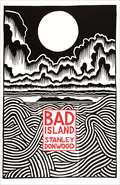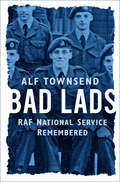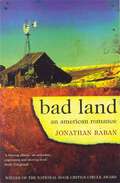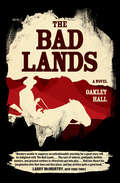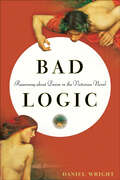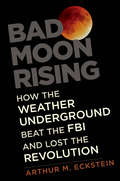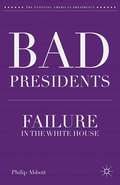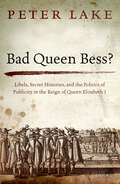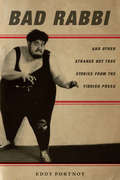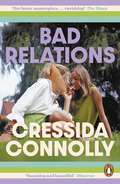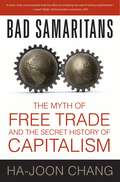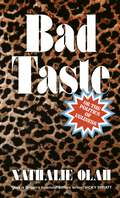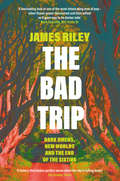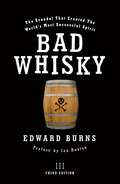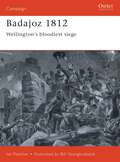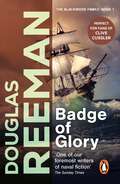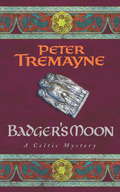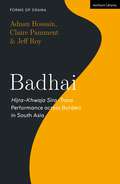- Table View
- List View
Bad Island
by Stanley DonwoodFrom cult graphic designer and long-time Radiohead collaborator Stanley Donwood comes a starkly beautiful graphic novel about the end of the world.A wild seascape, a distant island, a full moon. Gradually the island grows nearer until we land on a primeval wilderness, rich in vegetation and huge, strange beasts. Time passes and man appears, with clubs, with spears, with crueller weapons still - and things do not go well for the wilderness. Civilisation rises as towers of stone and metal and smoke, choking the undergrowth and the creatures that once moved through it. This is not a happy story and it will not have a happy ending.Working in his distinctive, monochromatic linocut style, Stanley Donwood carves out a mesmerising, stark parable on environmentalism and the history of humankind.Praise for Stanley Donwood:'I've read lots of his stuff and it's always good and I am in no way biased' Thom Yorke, lead singer of Radiohead
Bad Lads: RAF National Service Remembered
by Alf TownsendBetween 1945 and 1963, over two and a half million eighteen-year-olds were called up for National Service. Alf Townsend was one of them, and here he tells his story - the highs and lows of life as a lowly Aircraftman Second Class in the early '50s. Before national service intervened, Alf was 'heading down the criminal road at top speed', having grown up in a north London slum, where money was short and local villains were revered. This book is a warts-and-all account of Alf's time in the RAF, when he was transplanted into a completely new world of misfits and officer types, rogues and entertainers, all amusingly described in his own inimitable style.
Bad Land: An American Romance
by Jonathan RabanJonathan Raban takes you on an enthralling journey into the least populated and least known region in the United States, the Great Plains of Montana, and finds there the heart and soul of the country.Bringing to life the extraordinary landscape of the prairie and the homesteaders whose dreams foundered there, and reaching through history to the present day, Bad Land uncovers the dangerous legacy of American innocence gone sour.'Bad Land should be recognized as a blazing classic' – Sunday Telegraph
The Bad Lands: A Novel
by Oakley HallIt’s 1883 in Johnson County, in the old Dakota Territory—a rugged, wide-open landscape of rolling, red earth, prairie, and cattle as far as the eye can see. But the land is closing, the “Beef Bonanza” is ending, and the free-range cattlemen are stuck watching a way of life disappear in a blaze of drought and gunfire. An action-packed western from one of the masters of the genre, Oakley Hall’s The Bad Lands blends roundups and rustlers, whorehouses and land grabs, shoot-outs and the threat of hangings in a tale of the war between the cowboys and the cattle barons. But more than this, it is an elegy to the wild beauty of the badlands before the ranchers moved in, chased off the free-rangers, the trappers, and the tribes, and fenced it all in.
The Bad Lands: A Novel
by Oakley HallIt’s 1883 in Johnson County, in the old Dakota Territory—a rugged, wide-open landscape of rolling, red earth, prairie, and cattle as far as the eye can see. But the land is closing, the “Beef Bonanza” is ending, and the free-range cattlemen are stuck watching a way of life disappear in a blaze of drought and gunfire. An action-packed western from one of the masters of the genre, Oakley Hall’s The Bad Lands blends roundups and rustlers, whorehouses and land grabs, shoot-outs and the threat of hangings in a tale of the war between the cowboys and the cattle barons. But more than this, it is an elegy to the wild beauty of the badlands before the ranchers moved in, chased off the free-rangers, the trappers, and the tribes, and fenced it all in.
The Bad Lands: A Novel
by Oakley HallIt’s 1883 in Johnson County, in the old Dakota Territory—a rugged, wide-open landscape of rolling, red earth, prairie, and cattle as far as the eye can see. But the land is closing, the “Beef Bonanza” is ending, and the free-range cattlemen are stuck watching a way of life disappear in a blaze of drought and gunfire. An action-packed western from one of the masters of the genre, Oakley Hall’s The Bad Lands blends roundups and rustlers, whorehouses and land grabs, shoot-outs and the threat of hangings in a tale of the war between the cowboys and the cattle barons. But more than this, it is an elegy to the wild beauty of the badlands before the ranchers moved in, chased off the free-rangers, the trappers, and the tribes, and fenced it all in.
The Bad Lands: A Novel
by Oakley HallIt’s 1883 in Johnson County, in the old Dakota Territory—a rugged, wide-open landscape of rolling, red earth, prairie, and cattle as far as the eye can see. But the land is closing, the “Beef Bonanza” is ending, and the free-range cattlemen are stuck watching a way of life disappear in a blaze of drought and gunfire. An action-packed western from one of the masters of the genre, Oakley Hall’s The Bad Lands blends roundups and rustlers, whorehouses and land grabs, shoot-outs and the threat of hangings in a tale of the war between the cowboys and the cattle barons. But more than this, it is an elegy to the wild beauty of the badlands before the ranchers moved in, chased off the free-rangers, the trappers, and the tribes, and fenced it all in.
Bad Logic: Reasoning about Desire in the Victorian Novel
by Daniel Wright"Reader, I married him," Jane Eyre famously says of her beloved Mr. Rochester near the end of Charlotte Bront;«;€™s novel. But why does she do it, we might logically ask, after all he;€™s put her through? The Victorian realist novel privileges the marriage plot, in which love and desire are represented as formative social experiences. Yet how novelists depict their characters reasoning about that erotic desire;¢;‚¬;€?making something intelligible and ethically meaningful out of the aspect of interior life that would seem most essentially embodied, singular, and nonlinguistic;¢;‚¬;€?remains a difficult question.In Bad Logic, Daniel Wright addresses this paradox, investigating how the Victorian novel represented reasoning about desire without diluting its intensity or making it mechanical. Connecting problems of sexuality to questions of logic and language, Wright posits that forms of reasoning that seem fuzzy, opaque, difficult, or simply "bad" can function as surprisingly rich mechanisms for speaking and thinking about erotic desire. These forms of "bad logic" surrounding sexuality ought not be read as mistakes, fallacies, or symptoms of sexual repression, Wright asserts, but rather as useful forms through which novelists illustrate the complexities of erotic desire.Offering close readings of canonical writers Charlotte Bront;«, Anthony Trollope, George Eliot, and Henry James, Bad Logic contextualizes their work within the historical development of the philosophy of language and the theory of sexuality. This book will interest a range of scholars working in Victorian literature, gender and sexuality studies, and interdisciplinary approaches to literature and philosophy.
Bad Logic: Reasoning about Desire in the Victorian Novel
by Daniel Wright"Reader, I married him," Jane Eyre famously says of her beloved Mr. Rochester near the end of Charlotte Bront;«;€™s novel. But why does she do it, we might logically ask, after all he;€™s put her through? The Victorian realist novel privileges the marriage plot, in which love and desire are represented as formative social experiences. Yet how novelists depict their characters reasoning about that erotic desire;¢;‚¬;€?making something intelligible and ethically meaningful out of the aspect of interior life that would seem most essentially embodied, singular, and nonlinguistic;¢;‚¬;€?remains a difficult question.In Bad Logic, Daniel Wright addresses this paradox, investigating how the Victorian novel represented reasoning about desire without diluting its intensity or making it mechanical. Connecting problems of sexuality to questions of logic and language, Wright posits that forms of reasoning that seem fuzzy, opaque, difficult, or simply "bad" can function as surprisingly rich mechanisms for speaking and thinking about erotic desire. These forms of "bad logic" surrounding sexuality ought not be read as mistakes, fallacies, or symptoms of sexual repression, Wright asserts, but rather as useful forms through which novelists illustrate the complexities of erotic desire.Offering close readings of canonical writers Charlotte Bront;«, Anthony Trollope, George Eliot, and Henry James, Bad Logic contextualizes their work within the historical development of the philosophy of language and the theory of sexuality. This book will interest a range of scholars working in Victorian literature, gender and sexuality studies, and interdisciplinary approaches to literature and philosophy.
Bad Moon Rising: How the Weather Underground Beat the FBI and Lost the Revolution
by Arthur M. EcksteinA startling history of the forlorn war between the Weather Underground and the FBI, based on interviews and 30,000 pages of previously unreleased FBI documents In the summer of 1970 and for years after, photos of Bill Ayers, Bernadine Dohrn, Jeff Jones, and other members of the Weather Underground were emblazoned on FBI wanted posters. In Bad Moon Rising, Arthur Eckstein details how Weather began to engage in serious, ideologically driven, nationally coordinated political violence and how the FBI attempted to monitor, block, and capture its members—and failed. Eckstein further shows that the FBI ordered its informants inside Students for a Democratic Society (SDS) to support the faction that became Weather during the tumultuous June 1969 SDS convention, helping to destroy the organization; and that the FBI first underestimated Weather’s seriousness, then overestimated its effectiveness, and how Weather outwitted them. Eckstein reveals how an obsessed and panicked President Nixon and his inner circle sought to bypass a cautious J. Edgar Hoover, contributing to the creation of the rogue Plumbers Unit that eventually led to Watergate.
Bad Presidents: Failure in the White House (The Evolving American Presidency)
by P. AbbottBad Presidents seeks to interpret the meaning of presidential 'badness' by investigating the ways in which eleven presidents were 'bad.' The author brings a unique, and often amusing perspective on the idea of the presidency, and begins a new conversation about the definition of presidential success and failure.
Bad Queen Bess?: Libels, Secret Histories, and the Politics of Publicity in the Reign of Queen Elizabeth I
by Peter LakeBad Queen Bess? analyses the back and forth between the Elizabethan regime and various Catholic critics, who, from the early 1570s to the early 1590s, sought to characterise that regime as a conspiracy of evil counsel. Through a genre novel - the libellous secret history - to English political discourse, various (usually anonymous) Catholic authors claimed to reveal to the public what was 'really happening' behind the curtain of official lies and disinformation with which the clique of evil counsellors at the heart of the Elizabethan state habitually cloaked their sinister manoeuvres. Elements within the regime, centred on William Cecil and his circle, replied to these assaults with their own species of plot talk and libellous secret history, specialising in conspiracy-driven accounts of the Catholic, Marian, and then, latterly, Spanish threats. Peter Lake presents a series of (mutually constitutive) moves and counter moves, in the course of which the regime's claims to represent a form of public political virtue, to speak for the commonweal and true religion, elicited from certain Catholic critics a simply inverted rhetoric of private political vice, persecution, and tyranny. The resulting exchanges are read not only as a species of 'political thought', but as a way of thinking about politics as process and of distinguishing between 'politics' and 'religion'. They are also analysed as modes of political communication and pitch-making - involving print, circulating manuscripts, performance, and rumour - and thus as constitutive of an emergent mode of 'public politics' and perhaps of a 'post reformation public sphere'. While the focus is primarily English, the origins and imbrication of these texts within, and their direct address to, wider European events and audiences is always present. The aim is thus to contribute simultaneously to the political, cultural, intellectual, and religious histories of the period.
Bad Queen Bess?: Libels, Secret Histories, and the Politics of Publicity in the Reign of Queen Elizabeth I
by Peter LakeBad Queen Bess? analyses the back and forth between the Elizabethan regime and various Catholic critics, who, from the early 1570s to the early 1590s, sought to characterise that regime as a conspiracy of evil counsel. Through a genre novel - the libellous secret history - to English political discourse, various (usually anonymous) Catholic authors claimed to reveal to the public what was 'really happening' behind the curtain of official lies and disinformation with which the clique of evil counsellors at the heart of the Elizabethan state habitually cloaked their sinister manoeuvres. Elements within the regime, centred on William Cecil and his circle, replied to these assaults with their own species of plot talk and libellous secret history, specialising in conspiracy-driven accounts of the Catholic, Marian, and then, latterly, Spanish threats. Peter Lake presents a series of (mutually constitutive) moves and counter moves, in the course of which the regime's claims to represent a form of public political virtue, to speak for the commonweal and true religion, elicited from certain Catholic critics a simply inverted rhetoric of private political vice, persecution, and tyranny. The resulting exchanges are read not only as a species of 'political thought', but as a way of thinking about politics as process and of distinguishing between 'politics' and 'religion'. They are also analysed as modes of political communication and pitch-making - involving print, circulating manuscripts, performance, and rumour - and thus as constitutive of an emergent mode of 'public politics' and perhaps of a 'post reformation public sphere'. While the focus is primarily English, the origins and imbrication of these texts within, and their direct address to, wider European events and audiences is always present. The aim is thus to contribute simultaneously to the political, cultural, intellectual, and religious histories of the period.
Bad Rabbi: And Other Strange but True Stories from the Yiddish Press (Stanford Studies in Jewish History and Culture)
by Eddy PortnoyStories abound of immigrant Jews on the outside looking in, clambering up the ladder of social mobility, successfully assimilating and integrating into their new worlds. But this book is not about the success stories. It's a paean to the bunglers, the blockheads, and the just plain weird—Jews who were flung from small, impoverished eastern European towns into the urban shtetls of New York and Warsaw, where, as they say in Yiddish, their bread landed butter side down in the dirt. These marginal Jews may have found their way into the history books far less frequently than their more socially upstanding neighbors, but there's one place you can find them in force: in the Yiddish newspapers that had their heyday from the 1880s to the 1930s. Disaster, misery, and misfortune: you will find no better chronicle of the daily ignominies of urban Jewish life than in the pages of the Yiddish press. An underground history of downwardly mobile Jews, Bad Rabbi exposes the seamy underbelly of pre-WWII New York and Warsaw, the two major centers of Yiddish culture in the late nineteenth and early twentieth centuries. With true stories plucked from the pages of the Yiddish papers, Eddy Portnoy introduces us to the drunks, thieves, murderers, wrestlers, poets, and beauty queens whose misadventures were immortalized in print. There's the Polish rabbi blackmailed by an American widow, mass brawls at weddings and funerals, a psychic who specialized in locating missing husbands, and violent gangs of Jewish mothers on the prowl—in short, not quite the Jews you'd expect. One part Isaac Bashevis Singer, one part Jerry Springer, this irreverent, unvarnished, and frequently hilarious compendium of stories provides a window into an unknown Yiddish world that was.
Bad Relations
by Cressida ConnollyA TALE OF A TRAGEDY SEEPING THROUGH GENERATIONS, AND A FAMILY FRACTURED BY HISTORY AND DESIRE 'The characters in Bad Relations are so brilliantly real, so wonderfully compelling at their best, and at their worst, that I can't get them out of my head. A wonderful novel' Nina StibbeOn the battlefields of the Crimea, William Gale cradles the still-warm body of his brother. William's experience of war will bring about a change in him that will reverberate through his family over the next two centuries.In the 1970s, William's descendants invite Stephen, a distant relation, to stay in their house in the English countryside - but their golden summer entanglements will end in a shocking fall from grace.Half a century later, a confrontation between the surviving members of the family will culminate in a terrible reckoning.'This is an Atonement-like novel about the messy stuff that is family life' Spectator'A writer who seems able to peer directly into the human heart' John Preston'A gripping story of love, loss and tragic betrayal' Country & Townhouse
Bad Samaritans: The Myth of Free Trade and the Secret History of Capitalism (Playaway Adult Nonfiction Ser.)
by Ha-Joon Chang"Lucid, deeply informed, and enlivened with striking illustrations." -Noam ChomskyOne economist has called Ha-Joon Chang "the most exciting thinker our profession has turned out in the past fifteen years." With Bad Samaritans, this provocative scholar bursts into the debate on globalization and economic justice. Using irreverent wit, an engagingly personal style, and a battery of examples, Chang blasts holes in the "World Is Flat" orthodoxy of Thomas Friedman and other liberal economists who argue that only unfettered capitalism and wide-open international trade can lift struggling nations out of poverty. On the contrary, Chang shows, today's economic superpowers-from the U.S. to Britain to his native Korea-all attained prosperity by shameless protectionism and government intervention in industry. We have conveniently forgotten this fact, telling ourselves a fairy tale about the magic of free trade and-via our proxies such as the World Bank, International Monetary Fund, and World Trade Organization-ramming policies that suit ourselves down the throat of the developing world. Unlike typical economists who construct models of how the marketplace should work, Chang examines the past: what has actually happened. His pungently contrarian history demolishes one pillar after another of free-market mythology. We treat patents and copyrights as sacrosanct-but developed our own industries by studiously copying others' technologies. We insist that centrally planned economies stifle growth-but many developing countries had higher GDP growth before they were pressured into deregulating their economies. Both justice and common sense, Chang argues, demand that we reevaluate the policies we force on nations that are struggling to follow in our footsteps.
Bad Taste: Or the Politics of Ugliness
by Nathalie OlahA timely critique of consumer culture which captures this image-obsessed moment in history, perfect for fans of Zadie Smith's Feel Free and Jia Tolentino's Trick Mirror.This book is not a taste, nor an anti-taste, manual. This is an interrogation of the importance we place on seemingly objective ideas of taste in a culture that is saturated by imagery, and the dangerous impact this has on our identities, communities and politics. This book is dedicated to understanding the industries of taste. From the food we eat to the way we spend our free time, Olah exposes the shallow waters of 'good' and 'bad' taste and the rigid hierarchies that uphold this age-old dichotomy. -How did minimalism become a virtue, and who can afford to do it justice?When did blue-collar jackets become a fashion item?Who stands to gain from the distinction made between beauty, and sex?- Bold, original and provocative, Bad Taste is a revelatory exploration of the intersection between consumerism, class, desire and power, and a rousing call-to-arms to break free from the restrictive ways we see those around us.
The Bad Trip: Dark Omens, New Worlds and the End of the Sixties
by James Riley'A history that makes perfect sense when the sky is falling down.' - The Sunday Times The Sixties, for many, was a time of new ideas, freedom, and renewed hope – from the civil rights movement to Woodstock. But towards the end of 1969 and the start of the 1970s, everything seemed to implode. The Manson murders, the tragic events of the Rolling Stones concert at Altamont and the appearance of the Zodiac Killer all called a halt to the progress of a glorious decade. At the end of the Sixties, the hippie dream died – or so the story goes. In The Bad Trip, James Riley descends into the underworld of the Sixties to reveal the dark side of the counterculture. He explores the seam of apocalyptic thinking that had lain hidden beneath the decade’s psychedelic utopianism all along. Moving between Britain and America, this is a magical mystery tour that shows just how different our concept of ‘the Sixties’ is from the reality of the period. A brilliant and trenchant cultural history published 50 years after the action – drawing on interviews with key figures from the music, art, and film scenes of the late 1960s and early 1970s in the US and UK.
Bad Whisky: The Scandal That Created The World's Most Successful Spirit
by Edward BurnsThis is the new edition of a cult classic released at a time when the industry is once more addressing the problem of defining what constitutes Scotch whisky. This is a unique insight into the Victorian scandal which raged at the end of the 19th century surrounding the adulteration of whisky in public houses throughout the UK. Returning to contemporary press reports and Hansard, Edward Burns masterfully unravels the scandal which eventually resulted in laws being passed which created safeguards for what is now known the world over as Scotch. In 1872 Scotland's spirituous reputation as a purveyor of fine Scotch whisky was shattered when it was discovered that some public house whisky contained poison. The extent of adulteration was widespread with additives such as meths, shellac gum, sulphuric acid, and boot polish all being used to pass off spirits as 'Scotch whisky'. The North British Daily Mail took up the fight against the practice when, out of 30 samples of 'whisky' taken out of public houses, only two were found to be the real thing. With some of the most prominent figures in Scottish public life joining the fray, the battle was on to clear up Scotch. Set against a worldwide background of gross food and drink adulteration that saw the poorer classes slowly poisoned by what they ingested, the results of the in-depth investigation were hardly surprising. They were, however, dismissed by those in authority as the product of a young scientist's over-imaginative mind, and as a consequence the whole sorry affair was forgotten and allowed to fade with memory. The events disclosed in this remarkable book have not re-entered the public arena since that time. Given the importance of the topic, and the furore that followed the revelations, it is rather strange that little mention of them is made in any of the whisky books currently in print.
Badajoz 1812: Wellington's bloodiest siege (Campaign)
by Bill Younghusband Ian FletcherThe storming of Badajoz was an epic action which involved Wellington's infantry in some of the most savage hand-to hand fighting of the whole Peninsular War. At appalling cost in a nightmare assault during the night of the 6 April 1812, Wellington's soldiers hacked their way over the bodies of their dead and wounded and through the huge medieval walls of the town. These were held with great tenacity, skill and courage by a resolute French and German garrison. Having stormed the town the battle-crazed army went berserk and the horrors of the sacking which followed, as much as the sublime courage of the attackers, have passed into legend.
Badajoz 1812: Wellington's bloodiest siege (Campaign #65)
by Bill Younghusband Ian FletcherThe storming of Badajoz was an epic action which involved Wellington's infantry in some of the most savage hand-to hand fighting of the whole Peninsular War. At appalling cost in a nightmare assault during the night of the 6 April 1812, Wellington's soldiers hacked their way over the bodies of their dead and wounded and through the huge medieval walls of the town. These were held with great tenacity, skill and courage by a resolute French and German garrison. Having stormed the town the battle-crazed army went berserk and the horrors of the sacking which followed, as much as the sublime courage of the attackers, have passed into legend.
Badge of Glory: (The Blackwood Family: Book 1): a compelling and captivating naval adventure from the master storyteller of the sea (The\royal Marines Saga Ser. #1)
by Douglas ReemanFans of Clive Cussler, Bernard Cornwell and Wilbur Smith will love this enthralling and colourful saga from multi-million copy bestselling author Douglas Reeman. The first novel in the Blackwood saga, spanning 150 years in the history of a great seafaring family, this an engrossing, all-action naval adventure that will keep you on the edge of your seat! 'One of our foremost writers of naval fiction' -- Sunday Times'Mr Reeman writes with great knowledge about the sea and those who sail on it' --The Times'I was engrossed from start to finish' -- ***** Reader review'Superb' -- ***** Reader review'Fantastic' -- ***** Reader review'My only fault was that I was disappointed when I got to the end' -- ***** Reader review'Another romping good yarn by my favourite author' -- ***** Reader review***********************************************************************************************1850: the age of Empire, the age of contrast, the age of dramatic change - one which would determine the destinies of nations as well as of men.Captain Philip Blackwood of the Royal Marines rejoins his ship, HMS Audacious that August, anxious to get back into action. Per Mare - Per Terram is the Marines' motto.In the torturous heat of Africa, where they are sent to stamp out the remaining strongholds of slavery, and later, in the bitter war of the Crimea, Philip Blackwood and his men learn to obey that motto without question...
Badger's Moon: A sharp and haunting Celtic mystery (Sister Fidelma #Bk. 13)
by Peter TremayneSuper sleuth Sister Fidelma returns in BADGER'S MOON, the thirteenth historical mystery by Peter Tremayne, acclaimed author THE HAUNTED ABBOT, SMOKE IN THE WIND and many more.PRAISE FOR THE SISTER FIDELMA SERIES: 'Rich helpings of evil and tension with lively and varied characters' Historical Novels Review, 'The detail of the books is fascinating, giving us a vivid picture of everyday life at this time' Irish Examiner A series of horrific murders has brought terror to the Kingdom of Muman. The victims, all young girls, were slaughtered with unspeakable violence on the nights of three consecutive full moons. Suspicion falls on three dark strangers from the distant land of Aksum (Ethiopia), who are guests at the Abbey of Finbarr. A panic-stricken mob attacks the abbey, leaving the religious in fear for their lives. Sister Fidelma and Brother Eadulf are called in to restore order and find the killer, but it soon becomes clear that the three mysterious strangers are hiding a dark secret. And what about the ageing Laig, a hermit-like apothecary, who is known to have instructed all three victims about the magic and power of the moon; what sinister truths are hidden in his dark woodland dwelling? As Fidelma struggles to repair her faltering relationship with Eadulf, can she uncover the truth before the killer strikes again on the next night of the full moon?What readers are saying about BADGER'S MOON:'Another exciting whodunit from the master of historic intrigue''Fast-paced and suspenseful, this Sister Fidelma mystery is a real page-turner''Complex and multi-layered - one of the best in the series so far'
Badhai: Hijra-Khwaja Sira-Trans Performance across Borders in South Asia (Forms of Drama)
by Adnan Hossain Claire Pamment Jeff RoyThis is the first full-length book to provide an introduction to badhai performances throughout South Asia, examining their characteristics and relationships to differing contexts in Bangladesh, India, and Pakistan. Badhai's repertoires of songs, dances, prayers, and comic repartee are performed by socially marginalised hijra, khwaja sira, and trans communities. They commemorate weddings, births and other celebratory heteronormative events. The form is improvisational and responds to particular contexts, but also moves across borders. For students of theatre and performance, anthropology, religion, gender and cultural studies, this book illuminates an important form of performance, considering its changing status and uncertain futures.The book draws from anthropology, theatre and performance studies, music and sound studies, ethnomusicology, queer and transgender studies, and sustained ethnographic fieldwork to examine badhai's place-based dynamics, transcultural features, and communications across the hijrascape. This vital study analyses these performances' layered, scalar, and sensorial practices, extending ways of understanding hijra-khwaja sira-trans performance.
Badhai: Hijra-Khwaja Sira-Trans Performance across Borders in South Asia (Forms of Drama)
by Adnan Hossain Claire Pamment Jeff RoyThis is the first full-length book to provide an introduction to badhai performances throughout South Asia, examining their characteristics and relationships to differing contexts in Bangladesh, India, and Pakistan. Badhai's repertoires of songs, dances, prayers, and comic repartee are performed by socially marginalised hijra, khwaja sira, and trans communities. They commemorate weddings, births and other celebratory heteronormative events. The form is improvisational and responds to particular contexts, but also moves across borders. For students of theatre and performance, anthropology, religion, gender and cultural studies, this book illuminates an important form of performance, considering its changing status and uncertain futures.The book draws from anthropology, theatre and performance studies, music and sound studies, ethnomusicology, queer and transgender studies, and sustained ethnographic fieldwork to examine badhai's place-based dynamics, transcultural features, and communications across the hijrascape. This vital study analyses these performances' layered, scalar, and sensorial practices, extending ways of understanding hijra-khwaja sira-trans performance.
